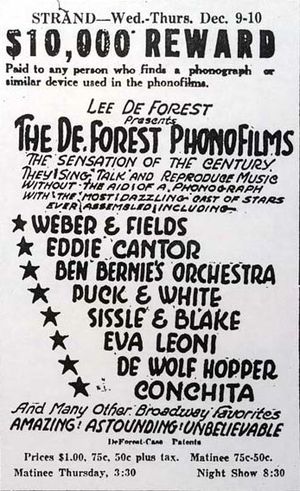Phonofilm
Even before 1920, silent films had become popular and were being shown in many cities around the world. Inventors, including heavyweights such as Thomas Edison, had spent thirty years trying to perfect a way to link the phonograph and motion pictures. Following his success with his Audion vacuum tube invention, Lee De Forest also experimented with sound systems for motion pictures, but he took a unique approach.
Instead of trying to match up sounds recorded on a phonograph disk with a motion picture projector, De Forest wanted to put the sound right on the film, next to the image. He did not do this with a groove like the phonograph, but used a completely different kind of recording called optical recording. His optical recorder converted sound into a pulsing beam of light, and then photographed the light to preserve a record of it on a narrow strip along the edge of the film. It is reproduced by a sensitive light detector, which converts the image into an electrical signal that can be amplified and heard through a loudspeaker.
De Forest was not the first to try to photograph sound, nor was he the first to try to make optical recordings for motion picture soundtracks. But he was one of the first to demonstrate a workable system. Between 1923 and 1925, his company, called DeForest Phonofilm, equipped over 30 theaters in the United States, Europe, South Africa, Australia, and Japan to use his system. DeForest struggled for several years to convince audiences to come see his movies, but by 1928 he sold the business. Although many thought his system worked well, DeForest never got the financial backing he needed, and his business simply never took off.
About the same time, however, several companies including Fox Movietone, Western Electric, Tonfilm (in Germany), and Tri-Ergon (also in Germany) were preparing to offer similar sound-on-film systems, and this was the type of technology that remained standard for motion pictures until the late 1940s.
